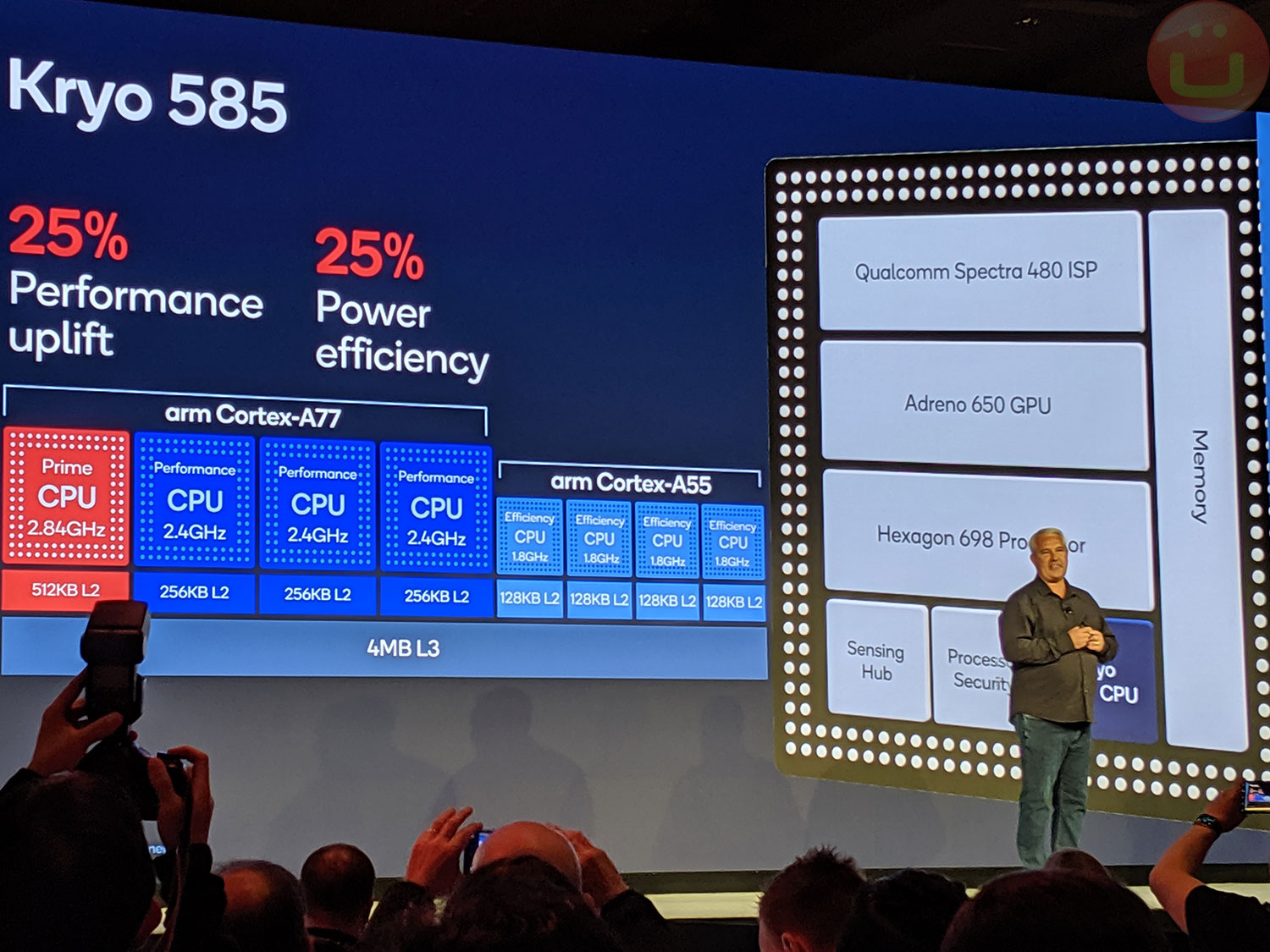
This Snapdragon 865 gaming overview deserves to have a standalone article because we’re going to refer to this page in future smartphone coverage. The number of updates since Snapdragon 855 is rather substantial and will have a significant impact on mobile gaming.
Kryo 585 CPU

As usual, the CPU clusters of Snapdragon 865 show performance and power-efficiency improvements in the order of ~25% (for each), according to Qualcomm. The CPU clusters are organized into three groups:
- 1x ARM Cortex-A77 “Prime” (2.84GHz)
- 3x ARM Cortex A77 “Performance” (2.4GHz)
- 4x ARM Cortex-A55 “Efficiency” (1.8GHz)
25% is very respectable for a year-over-year increase, and we’ll put that to the test when retail units arrive, but below are even bigger reasons why Snapdragon should remain the platform of choice for “Gaming phones” – a category which is nearly monopolized by Snapdragon 855 today.
Adreno 650 Graphics Processor

The graphics processor (GPU) also got a 25% peak performance improvement, along with a 35% increase in power-efficiency.
Again, that’s a very significant improvement, although GPU performance can be scaled a bit easier than CPU performance if you’re willing to make the GPU unit bigger.
The faster graphics performance is also supported by the presence of LPDDR5 memory, which increases the bandwidth when compared to LPDDR4. OEMs are free to use either, and this is perhaps something to look at when seeking the highest performance in the next-gen phones.
There are also performance metrics that typically don’t always show up in synthetic benchmarks, like sustained performance. Because Qualcomm tracks and has many ways to prioritize which compute units get more power and when, it is possible to keep thermals under control during gaming sessions. Reviewers can sometimes approximate this by running benchmarks back to back for a while.
On-stage, Qualcomm has demonstrated more advanced rendering use cases, with complex lighting and shadowing that are usually seen in Desktop PC games. Without a doubt, mobile rendering is right behind desktop rendering without missing a beat. As time goes on, the 3D technological migration will continue.

Qualcomm’s Adreno graphics unit is the primary reason why Snapdragon is the best Android gaming platform. For example, HiSilicon can often compete in CPU performance.
Apple remains a great competitor in synthetic GPU performance (but not in terms of overall gaming features), and we’d love to have cross-platform benchmarks or in-game benchmark to compare the two, as many modern graphics benchmark (OpenGL 3.1) don’t work on both platforms.
As general-purpose computing makes its way into mobile games, the powerful Snapdragon AI hardware could add even more contrast between different hardware vendors. That’s why in-game benchmarks are so important.
144Hz Displays

It’s impossible to talk about gaming without mentioning high framerates. 90Hz and 120Hz displays are already out there, but following the Snapdragon Summit, it’s clear that 144Hz mobile gaming phones are on their way in 2020.
"144HZ IS THE GOLD STANDARD"A highly responsive game allows the player to predict better what’s going to happen in the next seconds, and the response must happen as soon as possible, and 144Hz is the gold standard for gaming.
This chip can support multiple 4K/60Hz displays, but up to 3200×1800/144Hz on a single display (with HDR10+ support).
5G + Gaming

Since all Snapdragon 865 handset will support 5G, the extra bandwidth will, at the very least, encourage game studios to make higher-resolution content, which will then be downloaded faster.
But it also makes game streaming that much more practical. Many game streaming services already exist, such as Nvidia GameStream, Vortex, Shadow, and of course, Google’s Google Stadia.
5G’s sustained bandwidth and lower-latency can free gamers from the physical limitations of mobile computing by having the rendering done in a data-center.
Game Color Plus: Automatic Games Enhancements

The previous 3D rendering improvements are impressive, but what about legacy games? Qualcomm has a plan to make them better too. Game Color Plus is a driver-level enhancer for existing games.
When the conditions are right, Qualcomm can increase the clarity and boost the color, using algorithms such as Super-Resolution and other techniques to make games better after the fact, without changing one line of code.
Graphics Drivers Update Via Google Play Store

This leads us to the importance of having frequent driver updates. In the PC world, drivers are updated frequently because they are not associated with the operating system. The exact opposite was true in the mobile world.
Qualcomm and Google have worked together on decoupling the drivers from the operating system. When Android R arrives, Qualcomm will deliver GPU driver updates via the App Store, completely separated from OS updates.
Users should get more frequent performance tweaks, but it may also open the door to game-specific optimizations for massively popular games.
Conclusion
During its keynote, Qualcomm said that most people play games on their phones and that 80% of Chinese customers would be willing to pay more to get a “Gaming handset.”
Snapdragon 855 has proven to be the best Android gaming platform of 2019, and what we’ve seen so far points out to the high probability of having Snapdragon 865 is the best gaming android hardware of 2020.
The competition has been put on notice, and we’re looking forward to seeing ferocious competition in the coming months. Mobile Gaming is a hot market.
Disclaimer: Qualcomm is hosting a large group of international media to attend its Snapdragon Summit annual tech conference, including Ubergizmo. The opinions and analyses are our own, and Qualcomm does not get previews or have control over what we publish.
Filed in . Read more about Editorspick, Processors, Qualcomm, Snapdragon, Snapdragon Summit and SoC.